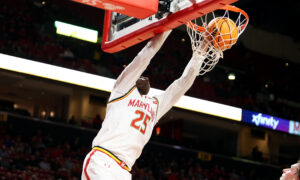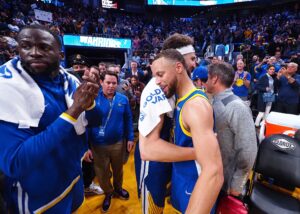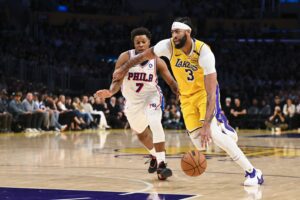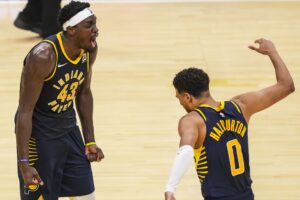This year’s NBA Finals matchup again features the Golden State Warriors vs. Cleveland Cavaliers. As the Warriors and Cavaliers meet in the Finals for the third consecutive season, the stage has been set for an epic end to the NBA season. With seven All-Stars and three MVPs shared between both teams, there will be multiple marquee matchups on the court at any given moment. Let’s look into the strategies and matchups that will decide this year’s NBA champion.
Golden State Warriors vs. Cleveland Cavaliers Film Preview
Key Actions
While both super-teams are capable of scoring in a myriad of ways, they each have a specific action that helps both define their offensive styles and strike fear into opponents’ coaching staffs. For Golden State, off-ball screens and relentless movement create open looks at the rim and from the perimeter. For Cleveland, two-man action between Kyrie Irving and LeBron James has proved impossible to stop when both stars are engaged offensively.
Can Cleveland Contain Golden State’s Off-Ball Movement?
One of the biggest talking points coming into this year’s playoffs was Cleveland’s vulnerable defense, which ranked 21st (in terms of defensive efficiency) in the regular season. While the Cavs have steamrolled through their Eastern Conference playoff opponents, they haven’t faced an offense nearly as lethal as Golden State’s.
Below, Golden State runs a simple cross-screen action in crunch time to tie the game. Stephen Curry curls off the baseline cut to set a back screen for Draymond Green, who gets an open dunk.
Notice Curry’s ability to be a uniquely effective screener. Iman Shumpert not only declines to hedge the back screen, but he actually opts to jump it because of his concern that Curry will fade to the three-point line. This is an incredibly difficult action for Kevin Love to account for with no hedge and no strong side help. Ideally, Love would not be defending Green as far out to the perimeter as he is in this clip, making himself much more difficult to screen. However, with Green hitting 47 percent of his threes this postseason, this may not be an option.
In the next clip, Curry again cuts baseline.
This time, Tristan Thompson switches out to the perimeter and is able to deflect the pass out of bounds. Switching can be an effective strategy, but it also provides more opportunity for errors. This is something we saw at the end of Cleveland-Boston Game 3, when Avery Bradley hit an open game-winning three as a result of J.R. Smith’s miscommunication. Switching will most likely be the strategy for Cleveland, but the Cavs will not have room for error against Golden State like they did against Boston.
Below, the Warriors run a simple triangle set with Zaza Pachulia in the pinch post. The bulk of Golden State’s half-court offense comes from triangle sets like these.
Cleveland again switches the dribble handoff and allows Pachulia to roll to the rim with the smaller defender on his back. Fortunately for the Cavs, Curry sees the roll late and turns the ball over after forcing the pass.
Can Golden State Contain the Irving/James Two-Man Game?
The most difficult action to defend that the Cavs present is the Irving/James one-three pick-and-roll. Irving’s offensive ability as a ball handler combined with James’ playmaking ability as a roll man make this screen both difficult to hedge and difficult to provide help on.
Below, James sets a high screen for Irving as part of Cleveland’s half-court set.
Notice that Zaza positions himself to help on the stong side action of the Kyrie/LeBron pick & roll. As a result, Looney drops to the weak side block allowing himself to get screened and give up the open three.
In the following clip, Irving is easily able to penetrate the lane against Curry.
When Kevin Durant shows help side, Andre Iguodala drops back to account for the weak side corner. However, the action is too fast for Klay Thompson to provide rotation help. James reads this perfectly and cuts for the thunderous slam to take the lead.
Key Matchups
Kyrie Irving vs. Stephen Curry
While Curry is the more consistent player in the regular season, we have seen Irving elevate his play for games against the Warriors in the past and win his matchup against Curry. Both players can score on each other in bunches and take over stretches of games with 15- or 20-point quarters.
Below, Irving hits a mid-range jumper over Curry.
Curry defends this isolation play well enough, but Irving can hit tough, contested shots, even against great defense. Not only did Irving make one of the most important shots in NBA history last year to clinch the championship for Cleveland, but he also hit the game winner in this year’s Christmas Day matchup against the Warriors.
Below, Curry gets into the lane with ease and finishes against Irving.
The Warriors may be able to survive another year of Irving outperforming Curry, given the added firepower of Kevin Durant. However, if Cleveland hopes to win this series, Irving will need to outplay Curry, or at least match his production.
LeBron James vs. Kevin Durant
Similar to the matchup above, both James and Durant are capable of besting each other on any given night. While James is the more accomplished player, his team is also far more reliant on his production. This matchup is particularly interesting because of how Cleveland likes to use James defensively. James can be an elite defender for individual possessions, but due to his importance to the Cavs offensively, he rarely guards the opposition’s star players. In the previous two regular season matchups, Durant guarded James far more than James guarded Durant, with Cleveland instead preferring Shumpert and Richard Jefferson to take Durant defensively.
Below, James isolates against Durant.
Against a smaller defender, James would bully his way to the basket with ease. Against a slower defender, James would have no problem facing up and making a move to get to the rim. James can still fill up the box score against Durant like he did in last year’s Finals, but Durant adds to the war chest of bodies that Steve Kerr or Mike Brown will have to throw at James, in addition to Green and Iguodala. James is still more than capable, but the addition of Durant does make things more difficult for him offensively.
Below, Durant grabs the miss and goes coast-to-coast to draw the foul.
Notice that James has to stay home on the perimeter with Curry filling the weak side lane. The Warriors’ elite spacing isn’t anything new, but Durant’s ability as a dynamic offensive weapon in their system certainly is. Durant has had a career year in terms of efficiency, and the clip above serves as evidence to that. Defenders just can’t help off of Curry or Thompson, and that has opened up the lane for Durant this year.
Below, James switches off of Durant after a screen by Green.
Immediately, as James drops, Durant rises and drills the corner three. If you’re wondering why James doesn’t draw the assignment of defending Durant, this is a perfect example of it. Defending Kevin Durant is a chore. Any mental lapse or shred of space and Durant will rise and shoot. Even James has his limits, and he is too valuable to Cleveland’s elite offense to also draw the assignment of defending Durant.
Key Questions
Can Kevin Love Make an Impact?
While Love has struggled with injuries during the last two Finals, Golden State is the worst matchup in the league for him on both ends of the floor. Love will have to find ways to make an impact for Cleveland to win this series.
Below, Durant switches onto Love in the post after Love sets a screen for James.
Love gets good position against Durant on the low block, but he is hesitant to go up with the shot. As a result, Love kicks the ball out, leading to the Cleveland turnover. The Warriors do exactly what the Cavs want them to. Love is one of the best low post scoring fours in the league, and Cleveland will often open the game trying to isolate Love against opposing small forwards off of switches. However, at nearly seven-feet tall, Durant doesn’t provide the size mismatch that Love would receive against most other NBA teams.
In the next clip, Love pump fakes and makes a strong move towards the basket.
Durant’s length at the rim causes Love to miss badly. Prior to the season’s start, there was concern about Golden State’s ability to protect the rim. While Pachulia isn’t the defensive presence that Andrew Bogut was, the addition of Durant allowed the Warriors to start two weak side shot blockers at the three and four spots. As a result, Golden State maintained its status as one of the best defensive teams in the league.
Finally, in this last clip, Love again forces Durant to switch onto him.
Against 29 other teams, this is a mismatch in favor of Cleveland. But against Golden State, Durant is again able to come up with the stop by forcing the turnover.
Can Draymond Green Control His Emotions?
Last year, Green’s suspension in Game 5 opened the door for what eventually became one of the greatest comebacks in NBA history. This year, Green’s technical and flagrant foul count likely won’t come into play with Golden State only needing to play 12 games to reach the Finals. However, Green’s temper has shown itself in this year’s regular season games against Cleveland.
Below, Green is on the receiving end of a phantom foul call early in the Christmas Day matchup.
Green immediately receives a technical foul for his initial reaction to the call. As he heads to the bench, Green continues to go after the referee and has to be calmed down by his teammates. It could have easily been two technicals, had it been a different referee.
Below, another questionable foul is called against Green.
In a one-possession game late in the fourth quarter, a technical foul could be disastrous. Green has to feed off of his emotion while also not letting it become a liability as it did in last year’s Finals.
Main Photo:






